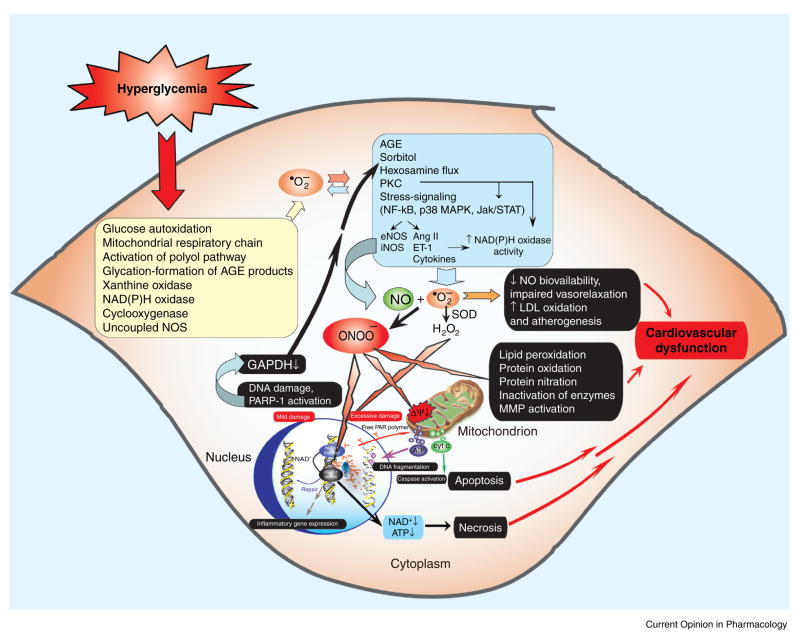Figure 1.
Mechanisms of cardiovascular dysfunction in diabetes: role of superoxide and peroxynitrite. Hyperglycemia induces increased superoxide anion (•O2−) production via activation of multiple pathways including xanthine and NAD(P)H oxidases, cyclooxygenase, uncoupled NOS, glucose autoxidation, the mitochondrial respiratory chain, polyol, and advanced glycation end products (AGEs). Superoxide activates AGEs, PKC, polyol (sorbitol), hexosamine and stress-signaling pathways, leading to increased expression of inflammatory cytokines, angiotensin II (Ang II), endothelin-1 (ET-1) and NAD(P)H oxidases, which in turn generate more superoxide via multiple mechanisms. Hyperglycemia-induced superoxide generation might also favour increased expression of NOSs through the activation of NF-κB, which increases the generation of NO. Superoxide anion quenches NO, thereby reducing the efficacy of a potent endothelium-derived vasodilator system. Superoxide can also be converted to hydrogen peroxide (H2O2) by superoxide dismutase (SOD) and interact with NO to form a reactive oxidant, peroxynitrite (ONOO−), which induces cell damage via lipid peroxidation, inactivation of enzymes and other proteins by oxidation and nitration, and activation of matrix metalloproteinases (MMPs). Peroxynitrite also acts on mitochondria to decrease the membrane potential (Ψ) and trigger the release of proapoptotic factors such as cytochrome c (Cyt c) and apoptosis-inducing factor (AIF). These factors mediate caspase-dependent and -independent apoptotic death pathways. Peroxynitrite, in concert with other oxidants (e.g. H2O2), causes strand breaks in DNA, activating the nuclear enzyme PARP-1. Mild damage to DNA activates the DNA repair machinery. By contrast, once excessive oxidative- and nitrosative stress-induced DNA damage occurs, overactivated PARP-1 initiates an energy-consuming cycle by transferring ADP-ribose units (small red spheres) from NAD+ to nuclear proteins, resulting in rapid depletion of the intracellular NAD+ and ATP pools, slowing the rate of glycolysis and mitochondrial respiration, and eventually leading to cellular dysfunction and death. Poly(ADP-ribose) glycohydrolase (PARG) degrades poly(ADP-ribose) (PAR) polymers, generating free PAR polymer and ADP-ribose, which signals to the mitochondria to induce AIF release. PARP-1 activation also leads to the inhibition of cellular glyceraldehyde- 3-phosphate dehydrogenase (GAPDH) activity which, in turn, favours the activation of PKC, AGEs and the hexosamine pathway, leading to increased superoxide generation. PARP-1 also regulates the expression of a variety of inflammatory mediators, which might facilitate the progression of diabetic cardiovascular complications.

